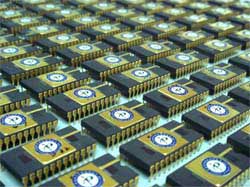| Posted: March 9, 2007 |
Chinese develop new type of MRAM |
|
(Nanowerk News) Thanks to its advantages such as data safety, anti-radiation, high speed, low density, energy-efficiency and long work life, the magnetic random access memory (MRAM) is considered a key device for the future computer, information and telecommunication technologies.
|
|
The new device consists of arrays of magnetic memory cells in which the information is stored as the magnetization direction of tiny ferromagnetic elements. In a conventional design scheme, writing these elements uses two crossed pulse currents to produce a synthesized magnetic field to reverse selected magnetic elements, and the read process relies on tunneling magneto-resistance (TMR) ratio.
|
 |
| Novel and conventional MRAM demo devices fabricated for a contrast experiment, showing the NR-MTJ memory cells and current switching technique can remarkably decrease the energy consumption and increase storage density. (Image: CAS)
|
|
With the joint support of National Basic Research Program (973 Program), the National Natural Science Foundation of China, and CAS Knowledge Innovation Program between 04/2002 and 09/2006, a research team led by Prof. HAN Xiufeng from the CAS Institute of Physics has recently developed a demo device for a new type of MRAM.
|
|
Instead of using the traditional way of fabrication, the researchers adopt a principle they have worked out that takes nano-ring-type magnetic tunnel junctions (NR-MTJs) with the outer- and inner-diameter of around 100 and 50 nm as memory cells and employs positive and negative pulse current to directly drive the rotation of magnetic moment on a bit plane.
|
|
Scientists say that their invention could overcome the difficulties of high energy consumption and low storage density, two bottleneck problems of MRAM development. Only 500 ∼ 650 µA (microampere) or less such a current is needed for a device cell to perform the writing operation, and 10 ∼ 20 µA (microampere) current can be used to perform the reading operation. After further improvement, it is expected to further decrease the writing current to 100 ∼ 200 µA (microampere).
|
|
Such a design concept and framework, according to researchers, could greatly upgrade the possibility of fabricating high-performance but low-cost MRAM.
|

